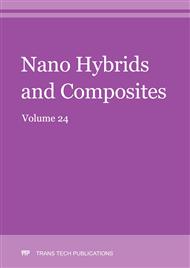[1]
A. Meddah, M. Beddar, A. Bali, Use of shredded rubber tire aggregates for roller compacted concrete pavement, J. Clean. Prod. 72 (2014) 187–192.
DOI: 10.1016/j.jclepro.2014.02.052
Google Scholar
[2]
M. Mastali, A. Dalvand, A. Sattarifard, The impact resistance and mechanical properties of the reinforced self-compacting concrete incorporating recycled CFRP fiber with different lengths and dosages, Compos. Part B Eng. 112 (2017) 74-92.
DOI: 10.1016/j.compositesb.2016.12.029
Google Scholar
[3]
M. Bravo, J. De Brito, Concrete made with used tyre aggregate: Durability-related performance, J. Clean. Prod. 25 (2012) 42–50.
DOI: 10.1016/j.jclepro.2011.11.066
Google Scholar
[4]
A. Meddah, H. Bensaci, M. Beddar, A. Bali, Study of the effects of mechanical and chemical treatment of rubber on the performance of rubberized roller-compacted concrete pavement, Innov. Infrastruct. Solut. 2 (2017) 17.
DOI: 10.1007/s41062-017-0068-5
Google Scholar
[5]
N.N. Eldin, A. Senouci, Rubber-tire particles as concrete aggregate, J. Mater. Civ. Eng, 5 (1993) 478–496.
DOI: 10.1061/(asce)0899-1561(1993)5:4(478)
Google Scholar
[6]
H. Bensaci, B. Menadi, S. Kenai, W. Yahiaoui, Performance of self-compacting rubberized concrete, MATEC Web Conf. 149 (2018).
Google Scholar
[7]
N. Ganesan, J. Bharati Raj, A.P. Shashikala, Flexural fatigue behavior of self compacting rubberized concrete, Constr. Build. Mater. 44 (2013) 7–14.
DOI: 10.1016/j.conbuildmat.2013.02.077
Google Scholar
[8]
A. Benazzouk, O. Douzane, K. Mezreb, B. Laidoudi, M. Quéneudec, Thermal conductivity of cement composites containing rubber waste particles: Experimental study and modelling, Constr. Build. Mater. 22 (2008) 573–579.
DOI: 10.1016/j.conbuildmat.2006.11.011
Google Scholar
[9]
W. Her, L. Chin, L. Hsien, A study of the durability properties of waste tire rubber applied to self-compacting concrete, Constr. Build. Mater. 41 (2013) 665–672.
DOI: 10.1016/j.conbuildmat.2012.11.019
Google Scholar
[10]
M. Mastali, A. Dalvand, Use of silica fume and recycled steel fibers in self-compacting concrete (SCC), Constr. Build. Mater. 125 (2016) 196–209.
DOI: 10.1016/j.conbuildmat.2016.08.046
Google Scholar
[11]
E. Khalil, M. Abd-Elmohsen, A.M. Anwar, Impact Resistance of Rubberized Self-Compacting Concrete, Water Sci. 29 (2015) 45–53.
DOI: 10.1016/j.wsj.2014.12.002
Google Scholar
[12]
Kırgız, M.S., Pulverized Fuel Ash Cement Activated by Nanographite,, ACI Materials, Vol. 115, No. 6, p.803–812, (2018).
DOI: 10.14359/51689101
Google Scholar
[13]
Kırgız, M.S., Green cement composite concept reinforced by graphite nano-engineered particle suspension for infrastructure renewal material, Composites Part B: Engineering, Vol. 154, No. 12, p.423–429, 2018.
DOI: 10.1016/j.compositesb.2018.09.012
Google Scholar
[14]
Kırgız, M.S., Effect of mineralogical substitution raw material mixing ratio on mechanical properties of concrete, ZKG International, No. 10, p.30–41, (2018).
Google Scholar
[15]
Kırgız, M.S., Advancements in Mechanical and Physical Properties for Marble Powder–Cement Composites Strengthened by Nanostructured Graphite Particles, Mechanics of Materials, Vol. 92, No.1, p.223–234, 2016.
DOI: 10.1016/j.mechmat.2015.09.013
Google Scholar
[16]
Kırgız, M.S., Advance Treatment by Nanographite for Portland Pulverised Fly Ash Cement (The class F) Systems,, Composites Part B: Engineering, Vol. 82, No. 12, p.59–71, 2015.
DOI: 10.1016/j.compositesb.2015.08.003
Google Scholar
[17]
Kırgız, M.S., Supernatant Nanographite Solution for Advance Treatment of C Class Fly Ash–Cement Systems (Part 2),, ZKG International, No. 5, p.42–47, (2015).
Google Scholar
[18]
Kırgız, M.S., Supernatant Nanographite Solution for Advance Treatment of C Class Fly Ash–Cement Systems (Part 1),, ZKG International, No. 4, p.56–65, (2015).
Google Scholar
[19]
O.M. Okamura H, Self-compacting concrete: development, present use and future, in: Frst Int. Conf. Self-Compacting Concr. (1999) 3–14.
Google Scholar
[20]
EFNARC, The European Guidelines for Self-Compacting Concrete, in: Eur. Guidel. Self Compact. Concr., (2005).
Google Scholar
[21]
Kırgız, M.S., Fresh and Hardened Properties of Green Binder Concrete Containing Marble Powder and Brick Powder, European Journal of Environmental and Civil Engineering, Issue sup1: Supplement: Green Binder Materials for Civil Engineering and Architecture Applications, Vol. 20, pp.64-101, 2016.
DOI: 10.1080/19648189.2016.1246692
Google Scholar
[22]
Kırgız, M.S., Use of ultrafine marble and brick particles as alternative raw materials for clinkerization,, ZKG International, No.4, p.36–44, (2014).
Google Scholar
[23]
Kırgız, M.S., Use of ultrafine marble and brick particles as raw materials in cement manufacturing,, Materials and Structures, Vol. 48, No. 9, p.2929–2941, (2015).
DOI: 10.1617/s11527-014-0368-6
Google Scholar
[24]
Kırgız, M.S., Strength Gain Mechanism for Green Mortar Substituted Marble Powder and Brick Powder for Portland Cement, European Journal of Environmental and Civil Engineering, Issue sup1: Supplement: Green Binder Materials for Civil Engineering and Architecture Applications, Vol. 20, pp.38-63, 2016.
DOI: 10.1080/19648189.2016.1246691
Google Scholar
[25]
Kırgız, M.S., Experimental study on pH-assisted bending strength gain projection for green mortar composite containing brick powder as substitution by-product, European Journal of Environmental and Civil Engineering, 2017.
DOI: 10.1080/19648189.2017.1357740
Google Scholar
[26]
Kırgız, M.S., Advances in physical properties of C class fly ash–cement systems blended nanographite (Part 2),, ZKG International, No.1-2, p.60–67, (2015).
Google Scholar
[27]
Kırgız, M.S., Advances in physical properties of C class fly ash–cement systems blended nanographite (Part 1),, ZKG International, No.12, p.42–48, (2014).
Google Scholar
[28]
Kırgız, M.S., Strength Gain Mechanisms of Blended-Cements Containing Marble Powder and Brick Powder,, KSCE Journal of Civil Engineering, Vol. 19, No.1, p.165–172, 2015.
DOI: 10.1007/s12205-014-0557-4
Google Scholar
[29]
Kırgız, M.S., Effects of Blended–Cement Paste Chemical Composition Changes on Some Strength Gains of Blended–Mortars,, Materials Science / Journal of Scientific World, Vol.2014, pp.1-11, 2014.
DOI: 10.1155/2014/625350
Google Scholar
[30]
Kırgız, M. S., Chemical properties of blended cement pastes,, Journal of Construction Engineering and Management, Vol. 137, No. 12, p.1036–1042, 2011.
Google Scholar
[31]
R. Siddique, G. Kaur, Kunal, Strength and permeation properties of self-compacting concrete containing fly ash and hooked steel fibres, Constr. Build. Mater. 103 (2016) 15–22.
DOI: 10.1016/j.conbuildmat.2015.11.044
Google Scholar


